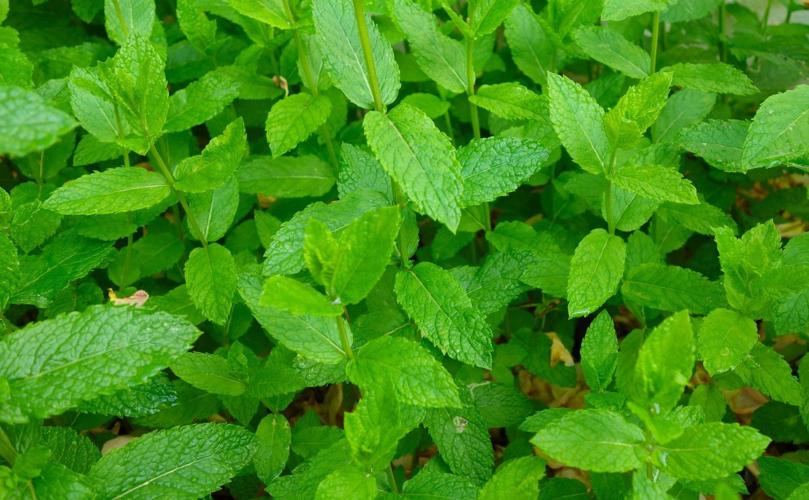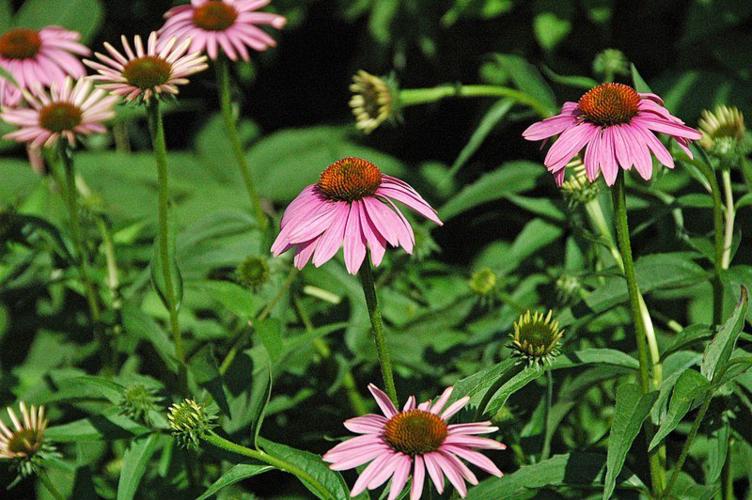February 23, 2021 by Jeanette Rueb
Growing Your Own Herbal Tea
If you’re a member of the Garden Revival Discord server, you’ve probably met the delightful Jeanette Rueb, aka Peachy00Keen. But you might not know that for the past six years Jeanette has published Apartment Eats — a weekly cooking blog. Growing up in a close knit, food loving Italian family, she began baking cookies at the tiny adorable age of three, at her Nana’s apron strings. Her culinary education continued at her mother’s side, as she learned to improvise and experiment in the kitchen. She went on to study journalism (among other things — she’s a real renaissance woman) and now has hundreds of Apartment Eats posts under her belt, as well as news articles galore on the subjects of history and science, with occasional pieces on DIY, home and garden, and viral entertainment.
Jeanette loves tea. She drinks it by the bucketful. By her own admission, Jeanette bleeds Earl Grey when she gets a paper cut. Today, she brings us a post on the basics of growing plants that can be dried for herbal tea. But she has many more blog posts on the subject of tea on Apartment Eats, including her signature Peachy Keen Tea recipe. If you’d like some folk remedy recipes for common ailments, check out her blog post on basic remedy teas and this one on Iced Lemon Ginger Tummy Tea.
— IG
As we head into spring (or wishfully think about it), it’s time to think about what we can add to our kitchen from the Earth around where we live. Not only does growing your own produce save you money, but it doesn’t require a lot of space. Container gardening works well for many plants, from herbs and flowers to fruits and veggies.
Today’s post will cover the basics of growing some plants that can be dried for herbal tea. We’ll discuss USDA plant hardiness zones, soil conditions, water, sun, and everything else you ought to need to get started growing your very own tea garden. All of these plants, with the exception of rosehips, can be hung to dry. If you’d like some tips on how to go about doing that, take a look at my article on How To Hang Dry Plants. Alternatively, if you’d like to learn how to press-dry plants to keep a journal of what you grow, Garden Revival has you covered. Now, without any further ado — Plants!
Roman Chamomile (Chamaemelum nobile)

Chamomile is a member of the daisy family, the same botanical family as another flower we’ll discuss later, echinacea. Roman chamomile is “true” chamomile, though German chamomile (Matricaria chamomilla syn. Matricaria recutita) is used interchangeably as an herb and grows under similar conditions.
When it comes to identification, Roman chamomile (also called Russian or English chamomile) grows as a creeping, perennial ground cover with feathery-looking leaves and small, white flowers bearing a bulbous yellow center. German chamomile, by contrast, is a reseeding annual that grows upright to roughly knee-height and produces larger, singular flowers on stalks, with elongated white petals and sunny yellow centers.
As a tea, chamomile is often used as a sleep and relaxation aid, a practice dating back to the Ancient Romans and Egyptians. It can also help alleviate inflammation, menstrual cramps, and some of the symptoms of hay fever (seasonal allergies), among other ailments. Sounds cool, right? Science thinks so, too. Here’s what you need to know to grow some for yourself.
- Hardiness Zones: 3-9
- Soil Conditions: Well-draining; tolerates poor soil; neutral pH
- Water Needs: Low; drought-tolerant
- Light Needs: Part shade to full sun
- Fertilizer Needs: Minimal; over-fertilizing can sap flavor
- Potential Pests: Pest-deterrent; susceptible to aphids, mealybugs, and thrips if drought-weakened
- Harvesting: Summer; will continuously bloom if regularly harvested; pick flowerheads at full bloom, just before the petals begin to droop downward; lay in open air to dry
- Container-Friendly: Yes
- Growable Indoors: Yes
English Lavender (Lavandula angustifolia)

Lavender is a popular, easy-to-grow perennial plant that comes in more varieties than there are flavors of cereal. When it comes to tea and baking, English lavender and French lavender (Lavandula stoechas) are typically used. It’s an incredibly hardy plant, particularly if you have a habit of forgetting to water things or live in an area with garbage soil.
Identifying lavender is fairly straightforward. Most varieties you’ll encounter grow as a shrub with narrow leaves and clusters of bluish-purple flowers growing on a spike. English lavender grows to about knee-height and gets to be one to two times as wide as it is tall. Lavender is a bee’s best friend. The fragrant, colorful blooms draw fuzzy buzzy pollinators all season long!
Herbally, lavender is often used as a calming plant to ease anxiety, depression, and trouble sleeping. The scientific studies backing claims of its efficacy as a sort of herbal panacea look promising, but there are still some clinical hurdles to overcome. If nothing else, lavender makes a delicious addition to baked goods and relaxing cuppas alike, particularly when paired with lemon and honey.
- Hardiness Zones: 5-8
- Soil Conditions: Well-draining; tolerates poor soil; neutral pH
- Water Needs: Dry to moderate; drought-tolerant
- Light Needs: Full sun
- Fertilizer Needs: Not needed
- Potential Pests: Spittlebugs, aphids
- Harvesting: Summer, just as the blooms begin to open; hang dry
- Container-Friendly: Yes – large, well-draining pots
- Growable Indoors: Yes, though possibly difficult due to space and light needed
Damask Roses (Rosa damascena)

A rose is a rose by any other name, but does it still make tea? The answer, in short, is yes, but your mileage may vary. If it’s rose hips you’re looking to harvest, just about any variety of rose will produce them at the end of the growing season, though none quite as generously as Rugosa roses (Rosa rugosa). If your love for ornamentals prevents you from growing old, shrubby-style bushes, consider harvesting wild rose hips (as long as you know they haven’t been chemically treated). When it comes to petals, though, Damask roses steal the show.
With flower heads that sometimes more closely resemble that of a peony than a rose, Damask roses produce beautiful, petal-laden blossoms that carry a fragrance like no other. Their powerful aroma makes them ideal for tea, baking, or infusing to make rosewater. If you leave some heads behind to wither, the same plant will give you rose hips, which can also be used in tea. The perennial bushes themselves grow to be about five feet (1.5 meters) tall.
The benefits of consuming roses are fairly straightforward. Rose petals and hips alike are packed with Vitamin C, which is always good to have in your system during cold and flu season. Rosewater is a delightful addition to baked goods, and can soothe mildly-irritated skin when applied topically. If you crave that vitamin, consider planting a variety touted for its hips, and if you live at altitude, nature will give your plants an extra boost in vitamin production. Here’s the run-down for Damask roses:
- Hardiness Zones: 4-8
- Soil Conditions: Well-drained, moist soil is preferred but will grow in just about anything; neutral pH
- Water Needs: Moderate to abundant
- Light Needs: Part shade to full sun
- Fertilizer Needs: Organic fertilizer annually, in late fall
- Potential Pests: Honey fungus
- Harvesting: Harvest blooms in the morning during summer when fully opened, pluck petals, spread on a towel, and dry in a shaded area; leave heads on plant to wither to harvest ripe hips in late summer and early fall, when they are red and full, dry in a low-temp oven or dehydrator
- Container-Friendly: Yes, but you need a big pot that drains well
- Growable Indoors?: No
Peppermint (Mentha x piperita)

Peppermint is the perfect plant for beginners, tea fiends, and anyone who can’t seem to handle plants without killing them. It’s a perennial hybrid of spearmint (Mentha spicata) and watermint (Mentha aquatica), and can be grown in much the same conditions as just about any other member of the mint family. It’s a vigorous grower that is best kept contained, lest it overtake your garden (or your entire neighborhood).
Trying to identify an existing mint plant can be somewhat intimidating as there are a lot of varieties. Peppermint and spearmint tend to be the most common, and can be differentiated by their leaf shape. Peppermint leaves are elongated and pointed at the tip, whereas spearmint leaves are more rounded. Both plants grow as a tall ground cover, proliferating wherever they are planted up to roughly knee-height.
Of all the tea plants you can grow in your yard, peppermint has to be the most foolproof. You can harvest multiple times per season, enough to supply you with tea for an entire year, just from a small patch. It can help ease upset stomachs and soothe headaches, all while tasting amazing.
- Hardiness Zones: 3-11
- Soil Conditions: Fertile; moist; balanced pH
- Water Needs: Moderate to abundant, not drought-tolerant
- Light Needs: Full sun to part shade
- Fertilizer Needs: Organic fertilizer annually, in spring
- Potential Pests: Spider mites, loopers, flea beetles; generally pest-resistant
- Harvesting: Pick leaves/cut stems at midday summer through fall; hang to dry; crumble dry leaves for tea, discarding the stems
- Container-Friendly?: Yes (suggested, in fact)
- Growable Indoors?: Yes
Purple Coneflower (Echinacea purpurea)

Echinacea or purple coneflower is yet another member of the delightful daisy family. The colorful cousin of chamomile, echinacea makes a beautiful addition to any garden, and in addition to looking nice and tasting good, they smell lovely. They really are the trifecta of flora.
These bushy flowers grow in perennial clusters with dense, low foliage and large, solitary, purple flowers on tall stalks. Each echinacea plant can grow to be up to four feet (1.3 meters) tall and one to three feet (0.3 to 1 meter) wide. They’re perfect for cutting to use in flower arrangements, and they make a beautiful accent or centerpiece plant in any garden.
Tea made from echinacea flowers is a popular cold and flu remedy. While it won’t cure you of the ailment, it’ll make the symptoms considerably more bearable. Other uses as an anti-inflammatory and anti-cancer agent have been touted and are currently the subject of study for future medicinal use.
- Hardiness Zones: 5-8
- Soil Conditions: Well-drained, moist soil; tolerates poor, rocky soil; pH neutral
- Water Needs: Low to moderate
- Light Needs: Full to partial sun
- Fertilizer Needs: Organic fertilizer in spring
- Potential Pests: Powdery mildew, aphids, Japanese beetles
- Harvesting: Cut entire stalks at peak bloom in late summer/early fall; hang to dry; crumble dry leaves and petals, discarding stems
- Container-Friendly?: Yes, requires a deep pot to accommodate the taproot
- Growable Indoors?: No